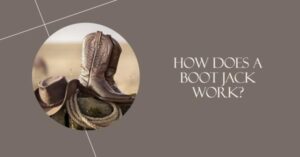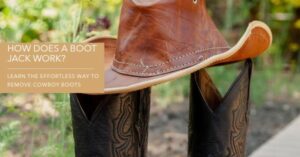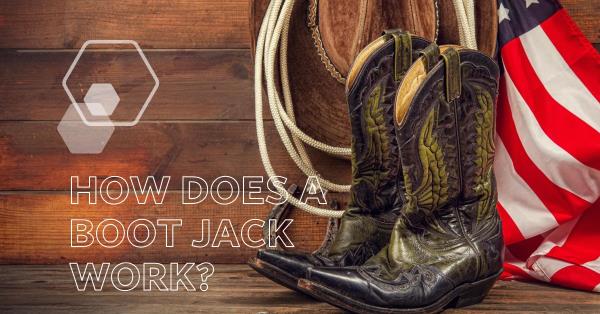Table of Contents
- 1 How Does a Boot Jack Work? The Most Efficient Way to Remove Your Cowboy Boots
- 2 How a Boot Jack Works
- 3 Using a Boot Jack
- 4 Design and Materials of Boot Jacks
- 5 Other Types of Boot Jacks
- 6 FAQ for “How Does a Boot Jack Work?”
- 6.1 What is a boot jack?
- 6.2 Does it matter what type of boot I am wearing when using a boot jack?
- 6.3 Is there any risk of damaging my boots using a boot jack?
- 6.4 Can a boot jack be used for other footwear besides traditional boots, like shoes or ankle boots?
- 6.5 Where can I buy a boot jack?
- 6.6 Is there anything special to do in order to maintain my boot jack?
- 6.7 Are boot jacks necessary if you wear cowboy boots?
- 6.8 Are boot jacks worth it?
How Does a Boot Jack Work? The Most Efficient Way to Remove Your Cowboy Boots
A boot jack is a simple yet highly useful tool made to greatly simplify the process of removing cowboy boots, especially those with a tight fit or tall shafts.
Boot jacks are commonly made from either wood or plastic and their key feature is a U-shaped end section that provides a gripping function for the heel of the boot. The gripping section is usually protected with leather or other material to ensure that your boots aren’t damaged while taking them off. They are a real lifesaver for people who frequently wear boots and I use mine on a daily basis. They can greatly reduce the amount of straining and struggling that sometimes comes with boot removal.

So, how does a boot jack work and how do I use it?
The key message for us here is to know this: Using a boot jack is actually quite simple. It only takes a few easy steps to get your boots off comfortably and with minimal hassle.
First up – Place the boot jack on the floor. Next, step on the flat area nearest the floor with one foot (the one with the boot you aren’t trying to remove) and then place the opposite foot (with the boot you are trying to remove) in the front part of the boot jack shaped like a U. You should gently slide the heel of the boot you are trying to remove into the U-shaped mouth area of the boot jack and then with gentle, consistent pressure pull your foot up out of the boot slowly until it is removed.
Learning about this process and this tool was a game changer for easily taking off my cowboy boots. In my opinion, once you experience the ease of using a boot jack for boot removal, you are going to wonder how you ever got by without one.
Key Takeaways
- Boot jacks provide a simple, efficient way to remove cowboy boots.
- Using a boot jack is easy – it involves sliding your boot’s heel into the U-shaped mouth of the tool and gently pulling.
- Boot jacks make removing boots a more comfortable experience than trying to do it without one.

How a Boot Jack Works
The way a boot jack works is a combination of leverage, pressure, and unique design.
Leverage and Pressure
A boot jack works by combining the mix of leverage and pressure to help remove your boots with ease. As you place your heel in the U-shaped mouth of the boot jack and press it downward it grips the heel securely. In the process of simultaneously applying a downward pressure with your other foot on the flat area of the jack closest to the floor you create the counterpoint leverage that helps to lift your foot out of the boot.
U-shaped Mouth
The U-shaped design of the mouth, or entry point, of the boot jack is a universal design generally able to fit most boot heels. The proper U shape of the mouth of the jack is essential for the proper functioning of the boot jack as other designs in a V or square format can either make it harder to remove the boot or lead to the risk of damage during removal.

Using a Boot Jack
So, are boot jacks necessary? While they aren’t necessarily a necessity they are surely a nice to have. It is a fact that using a boot jack will make removing your boots a significantly easier process – and doubly so if they have a snug fit or are still breaking in. The boot jack is a simple yet ingenious tool.
Next up you will find a step-by-step guide on how to use a boot jack for cowboy boots:
- Place the boot jack on a stable surface: Ensure that the boot jack is positioned on a level and non-slippery surface to prevent it from moving while you’re using it.
- Secure the boot jack with one foot: Place one foot on the bottom end of the jack nearest the floor.
- Insert the heel of the other boot into the U-shaped mouth space: As you stabilize the jack with the other foot, place the heel of the boot you want to remove into the U-shaped end of the boot jack to ensure a snug grip on your boot’s heel.
- Gently pull your foot out of the boot: While keeping your foot on the boot jack, apply a gentle upward pulling force to slide your heel out of the boot while leaving your boot behind on the boot jack. You should be able to remove the boot without bending over or using your hands in the process.
- Repeat the process for the other boot: After you have removed one of your boots then you just switch up feet and follow the same process to remove the remaining boot.

Design and Materials of Boot Jacks
Boot jacks come in a few different designs and the materials used can vary widely. Most typically, you will find boot jacks that are made from materials such as wood, plastic, or metal. Each of these materials offers a different benefit in terms of durability, usability, and aesthetics.
Wooden boot jacks are a popular and widely found choice. They give off a classic appearance and have a good level of sturdiness. The design of wooden boot jacks can range from simple and essential to sophisticated and elegant that incorporates ornate carvings and decorations.
Plastic boot jacks are another common choice. Being both lightweight and easy to clean makes them a practical option for everyday use. The downside compared to wood is that plastic boot jacks are typically not as sturdy or long-lasting, but they may be a more affordable choice and can be more easily replaced if damaged. Plastic jacks will come in various colors and design options.
Metal boot jacks are going to excel in durability and can withstand heavy use and last for years. It is also common for metal jacks to feature elegant and intricate designs that make them both functional and visually appealing. A specific consideration for a metal boot jack is to be aware that it will generally be heavier than other material types. This could be an important deciding factor depending on your preference for portability.
Other Types of Boot Jacks
Folding Boot Jacks: If you have limited storage space or are looking for a portable solution a folding boot jack can be reduced to a flat, compact shape that allows you to carry it in your bag or store it away easily in a closet or drawer. The folding boot jack is convenient for travel or moving between locations. If you are wearing your cowboy boots traveling you should consider one of these for your luggage.

FAQ for “How Does a Boot Jack Work?”
What is a boot jack?
A boot jack is a simple device designed to aid in the removal of boots. It typically consists of a flat board with a U-shaped mouth on one end. The wearer will hook the heel of a boot in the U shape to keep it in place as the wearer pulls their foot out.
Does it matter what type of boot I am wearing when using a boot jack?
A boot jack can generally be used with most types of boots, from cowboy boots to work boots. The determining factor is that the boot needs to have a heel that can be hooked onto the boot jack.
Is there any risk of damaging my boots using a boot jack?
If used properly, a boot jack is unlikely to damage your boots. The point of contact is usually the heel and the U shaped area usually has a soft lining. If you have delicate materials or an unlined boot jack you may want to proceed with more caution.
Can a boot jack be used for other footwear besides traditional boots, like shoes or ankle boots?
The ability of a boot jack to be effective will largely depend on the footwear’s design. If the footwear doesn’t have a distinguishable heel to hook onto the jack it may not be as effective.
Where can I buy a boot jack?
Boot jacks are readily purchased in online and retail stores that sell western-style wear and at general online marketplaces like Amazon.
Is there anything special to do in order to maintain my boot jack?
Required maintenance will largely depend on the material of the boot jack. As a general rule, boot jacks require minimal upkeep. A few considerations are that wood boot jacks should be kept dry to prevent warping or cracking and those with padding should be cleaned regularly.
Are boot jacks necessary if you wear cowboy boots?
In my opinion, yes! But, no, boot jacks are not an absolute necessity item. However, they can be very helpful for individuals who wear their boots regularly and makes the boot removal process easier and more comfortable.
Are boot jacks worth it?
This is the big question right? It will come down to the user, but here we are big fans of the boot jack. For pretty much any boot wearers a boot jack greatly simplifies boot removal. Considering their relatively low cost many people find that boot jacks are worth the investment. Especially those who wear their cowboy boots everyday.
You can watch a Youtube video that is based on a summary of this article by going here: https://youtu.be/PrzGed5SDjI

